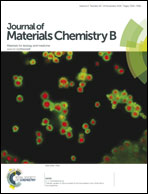Recombinant silk fibroin incorporated cell-adhesive sequences produced by transgenic silkworm as a possible candidate for use in vascular graft†
Abstract
Interest in vascular grafts has recently grown because more patients are undergoing procedures that involve these grafts. However, smaller grafts with diameters <6 mm made from conventional biomaterials are associated with a high incidence of thrombosis, and therefore the development of improved materials suitable for small vascular grafts is highly desirable. In this paper, four kinds of recombinant Bombyx mori silk fibroins were prepared using transgenic techniques for use as silk vascular graft with a diameter of <6 mm. The peptide sequence TS(CDPGYIGSRAS)8 derived from the laminin B1 chain or the combination of two kinds of sequences, TS(CDPGYIGSRAS)8 and (TGRGDSPAS)8 derived from fibronectin, was incorporated into the light (L)-chain or the heavy (H)-chain of the silk fibroin. The fractions of the incorporated peptide sequences range from 0.8% to 7.2% by weight in the recombinant silk fibroins. This incorporation causes a very small increase in the random coil fraction of silk fibroin and a decrease in the tensile strength. Compared with native silk fibroin, the adhesive activities of mouse endothelial and smooth muscle cells increase significantly with the recombinant silk fibroin films incorporating only the TS(CDPGYIGSRAS)8 sequence independent of the L- or H-chains. A similar tendency was observed for the high migration activities of the endothelial cells in vitro and also the longer migration distance of the endothelial cell from the anastomotic part of rat abdominal aorta in vivo when this recombinant silk fibroin was used as a coating material for the silk graft. In view of the results, the recombinant silk fibroin incorporating the laminin peptide sequence can be potentially used as a vascular graft material.


 Please wait while we load your content...
Please wait while we load your content...